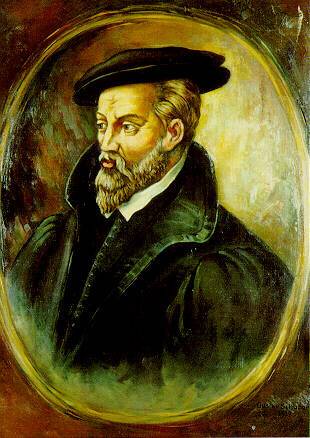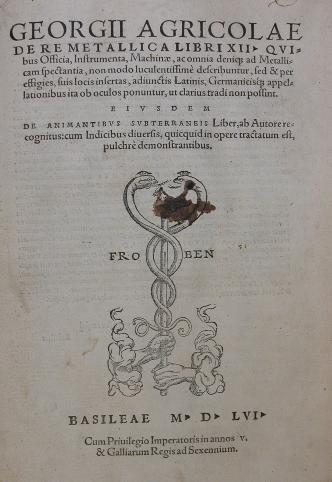<Back to Index>
- Mineralogist Georgius Agricola, 1494
- Novelist Olive Schreiner, 1855
- 2nd President of Italy Luigi Einaudi, 1874
PAGE SPONSOR


Georgius Agricola (24 March 1494 – 21 November 1555) was a German scholar and scientist. Known as "the father of mineralogy", he was born at Glauchau in Saxony. His real name was Georg Pawer; Agricola is the Latinised version of his name, Pawer/ (Bauer) meaning farmer. He is best known for his book De Re Metallica.
Gifted with a precocious intellect, Georg early threw himself into the pursuit of the "new learning", with such effect that at the age of twenty he was appointed Rector extraordinarius of Greek at the so-called Great School of Zwickau, and made his appearance as a writer on philology. After two years he gave up his appointment in order to pursue his studies at Leipzig, where, as rector, he received the support of the professor of classics, Peter Mosellanus (1493 - 1525), a celebrated humanist of the time, with whom he had already been in correspondence. Here he also devoted himself to the study of medicine, physics, and chemistry. After the death of Mosellanus he went to Italy from 1524 to 1526, where he obtained his doctor's degree.
He returned to Zwickau in 1527, and was chosen as town physician at Joachimsthal, a centre of mining and smelting works, his object being partly "to fill in the gaps in the art of healing," partly to test what had been written about mineralogy by careful observation of ores and the methods of their treatment. His thorough grounding in philology and philosophy had accustomed him to systematic thinking, and this enabled him to construct out of his studies and observations of minerals a logical system which he began to publish in 1528. Agricola's dialogue Bermannus, sive de re metallica dialogus (1530), the first attempt to reduce to scientific order the knowledge won by practical work, brought Agricola into notice; it contained an approving letter from Erasmus at the beginning of the book.
In 1530 Prince Maurice of Saxony appointed him historiographer with an annual allowance, and he migrated to Chemnitz, the centre of the mining industry, in order to widen the range of his observations. The citizens showed their appreciation of his learning by appointing him town physician in 1533. In that year, he published a book about Greek and Roman weights and measures, De Mensuis et Ponderibus.
He was also elected burgomaster of
Chemnitz. His popularity was, however, short-lived. Chemnitz was a
violent centre of the Protestant movement, while Agricola never wavered
in his allegiance to the old religion; and he was forced to resign his
office. He now lived apart from the contentious movements of the time,
devoting himself wholly to learning. His chief interest was still in
mineralogy; but he occupied himself also with medical, mathematical,
theological and historical subjects, his chief historical work being the Dominatores Saxonici a prima origine ad hanc aetatem, published at Freiberg. In 1544 he published the De ortu et causis subterraneorum, in which he laid the first foundations of a physical geology, and criticized the theories of the ancients. In 1545 followed the De natura eorum quae effluunt e terra; in 1546 the De veteribus et novis metallis, a comprehensive account of the discovery and occurrence of minerals and also more commonly known as De Natura Fossilium; in 1548 the De animantibus subterraneis; and in the two following years a number of smaller works on the metals. His most famous work, the De re metallica libri xii,
was published in 1556, though apparently finished in 1550, since the
dedication to the elector and his brother is dated 1550. It is a
complete and systematic treatise on mining and extractive metallurgy, illustrated with many fine and interesting woodcuts which
illustrate every conceivable process to extract ores from the ground
and metal from the ore, and more besides. Thus Agricola describes and
illustrates how ore veins occur in and on the ground, making the work
an early contribution to the developing science of geology. He describes prospecting for ore veins and surveying in great detail, as well as washing the ores to collect the heavier valuable minerals such as gold and tin. It is also interesting for showing the many water mills used in mining,
such as the machine for lifting men and material into and out of a mine
shaft. Water mills found innumerable applications, especially in
crushing ores to release the fine particles of gold and other heavy
minerals, as well as working giant bellows to
force air into the confined spaces of underground workings. It
contains in an appendix, the German equivalents for the technical terms
used in the Latin text. It long remained a standard work, and marks its
author as one of the most accomplished chemists of his time. Believing
the black rock of the Schlossberg at Stolpen to be the same as Pliny the Elder's basalt,
he applied this name to it, and thus originated a petrological term
which has been permanently incorporated in the vocabulary of science.
Until that time, Pliny's work Historia Naturalis was the main source of information on metals and mining techniques, and Agricola makes numerous references to the Roman encyclopedia. He describes many mining methods which are now redundant, such as fire-setting, which involved building fires against hard rock faces. The hot rock was quenched with water and the thermal shock weakened
it enough for easy removal. It was very dangerous when used in
underground galleries for the toxic gases given off by fires, and was
made obsolete by explosives.
De re metallica is considered a classic document of Medieval metallurgy, unsurpassed for two centuries. In 1912, the Mining Magazine (London) published an English translation. The translation was made by Herbert Hoover, an American mining engineer better known in his term as a President of the United States, and his wife Lou Henry Hoover.
In
spite of the early proof that Agricola had given of the tolerance of
his own religious attitude, he was not destined to end his days in
peace. He remained to the end a staunch Catholic, though all Chemnitz
had gone over to the Lutheran creed; and it is said that his life was ended by a fit of apoplexy brought
on by a heated discussion with a Protestant divine. He died in Chemnitz
on 21 November 1555; so violent was the theological feeling against
him, that he was not allowed to be buried in the town to which he had
added such lustre. Amidst hostile demonstrations he was carried to Zeitz, some fifty kilometers away, and buried there.